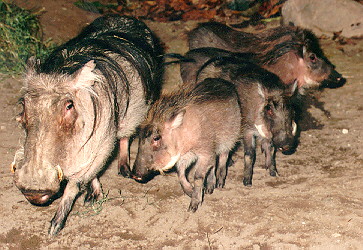
| THE CREATURE WITHIN | MAIN | STAR WARS | VEGAS | VINCENT | MUPPETS |
| WEBRING | THE WARTHOG |

Live:
The warthog is found is most open country of Africa south of the Sahara. This area includes the savanna of Ghana, Somalia, and South Africa. They prefer the open plains of the savanna, with a nearby water source for drinking and wallowing. For shelter they use aardvark burrows, which they back into in order to defend themselves from predators, or holes among rocks.
Physical Characteristics:
The warthog has long legs, a large shovel-shaped head, and a broad muzzle that bears tusks derived from the canine teeth. Warthogs have a body length ranging from 3 1/2 ft.-4 1/2 ft. and usually stand about 30 inches at the shoulder. Females are smaller in size than the males, with shorter tusks. The
sexes are also differentiated by the two wart-like protuberances on either side of the male's head. These two skin growths have no bony support or core, and it has been speculated that they serve to cushion the blows involved in males' ritual battles. The warthog has a sparse, bristly coat, with a long mane running to the middle of the back, and a few whiskers on the lower jaw. The tail of the animal is 13-19 inches long and is thin and tufted at the end. Warthogs carry their tails high and straight when running. The skin of the warthog resembles slate or clay in color and is very thick, often enabling the animal to escape being severly wounded. The tusks of the warthog are the feature most
striking in appearance. These tusks protrude from both upper and lower jaw. The shorter tusks of the lower jaw are used as sharp weapons, while those of the upper jaw curve upward and inward in
a semicircle. The upper tusks attain a length of more than 60 cm in some older males.
Food:
The warthogs graze on short grasses, feed on fruits and carrion, and also dig up bulbs, roots, and tubers. The vast bulk of the warthog's diet is made up of grasses. They sometimes eat carrion and bark from trees. Specialized incisors allow them to pluck the growing tips of grass shoots. During dry periods, a warthog uses the top edge of its nose to dig grass rhizomes out of the sun-baked dirt. Warthogs generally feed while kneeling. Tusks are not used for foraging, but rather for defense.
Reproduction:
Warthogs reach sexual maturity at 18-20 months of age, but most males do not usually mate until they are 4 years old. Males are generally solitary, only joining a group during breeding
periods. In such a period, males engage in ritualized fights for access to females. The breeding time of the warthog is synchronized with the local rainy seasons. These rainy seasons vary in month depending on the area. Females give birth to litters consisting of 1-8 young after a gestation period of 170-175 days. The young are born in a hole in the ground. These holes are either natural or made by aardvarks. They suckle for up to 4 months, but leave the burrow a week after they are born to feed on grass.
Behavior:
Generally gregarious animals, warthogs live in family groups in a territory that may be shared by more than one family. The population is divided into clans, each consisting of several bands and associated lone animals. Most bands (also called "sounders") contain 4-6 individuals, although groups of up to 40 have been reported. The members of these groups tend to have
lasting bonds with one another, especially the females. Adult males are usually solitary, but join female groups briefly for mating. At these times, males engage in highly ritualized battles. In these battles the upper tusks are used as weapons, so as not to seriously injure one another. Warthogs are not territorial, but sometimes competition for resources and waterholes occurs. Female warthogs also compete when raring young for opotune burrows -prefering deep fairly waterproof burrows- ussally taken by older stronger females.
Warthogs communicate through vocalizations including grunts, growls, snorts, and squeals. These calls are used for greeting, contact maintenance, threats, warnings, and submissions.
Unlike most wild pigs, warthogs are active in daylight. They may become noctournal where they are hunted by humans. They can run as fast as 55km/h (35 m/h). Their eyesight is poor but their sense of smell and hearing are acute.
The hunted:
Fully grown warthogs have few preditors. Thier tusks deteir many preditors such as jakels and cheters. However young warthogs are an important sourse of food for lions/lionesses during the dry season, when most larger herd animals have migrated. Young warthogs are also vulnerable to large birds of prey. Lionesses have aslo been known to dig out a single warthog corned in a burrow.
Conservation/Biodiversity:
Warthogs are of special concern because they have been hunted for many years and their populations have declined as a result. Since the safari hunts of the late 1800's, warthogs have been sought after for their tusks and for their energetic chases. As a result, they have been eliminated from most of South Africa, but they remain in moderate numbers in the rest of their original range. Relatively recently, conservation laws have been passed in several countries in order to protect warthog populations.
